[Retracted] Analysis on the Ecological Concept of Ternary Interactive Education in Business English Writing
Abstract
In order to improve the effect of business English writing education, this paper combines intelligent algorithms to study the ecological concept of ternary interactive education in business English writing and jointly identifies interference and source signals. Moreover, this paper derives the likelihood function of the received signal under the modulation mode of the interference and the source signal and jointly considers the information of the interference. The modulation recognition can well reduce the influence of interference on algorithm performance. In addition, this paper simulates the recognition performance of the likelihood function-based algorithm when the system has frequency offset and asynchronous time offset. Finally, this paper combines experimental research to verify that the business English education system based on the ternary interaction concept proposed in this paper can effectively improve the effect of business English writing education.
1. Introduction
At present, the teaching content cannot meet the actual needs of business. The existing business English writing teaching has explained and practiced various styles of business activities. However, there is no systematic and comprehensive overview of the knowledge of e-commerce and cross-border e-commerce. Business cooperation includes all aspects of commodity transactions, such as commodity quantity, price, attributes, shipment, delivery, and payment. What students receive is mainly English-based writing teaching, not systematic business writing teaching. If it is not in line with workplace needs and business practices, it will be difficult for students to quickly connect with practical business work after class. There is a gap between teaching methods and business practice [1]. Teaching philosophy has not kept up with business practice. Business English writing is highly practical, which makes teachers improve the traditional teaching concept and cannot always use “teacher” as the main body to explain knowledge, and students only accept it passively [2]. Teachers should be led, and students should become the main body of learning and actively participate in the classroom. Moreover, more practical aspects should be integrated into the classroom, and the teaching of business knowledge should be combined with practical teaching. In addition, it is necessary to think about business issues and workplace needs in the classroom and explore and improve workplace coping capabilities [3].
The context of business English determines that the discourse of business English letters has its own characteristics. Business English letters often emphasize one letter, and the content revolves around one theme. Therefore, “subjectline” is generally used in the letter to highlight the subject content and make the recipient clear at a glance. As a communication tool in international trade, business English letters have certain requirements on the genre structure and discourse structure of writing [4]. The business English context plays a certain restrictive role on both the writer and the reader of the letter, and the specific business environment must be referred to when writing. If the writing language of business English letters does not conform to the language habits and cultural habits of the other readers, it will affect the smooth progress of business activities. As large as the international business environment, as small as the business operation environment of a company, etc., all have certain influences and constraints on the writing of business English letters. Therefore, in the teaching of business English writing, teachers must teach students all kinds of contextual knowledge needed in the writing process [5].
Linguistic context is what is traditionally called contextual context. It plays a restrictive and explanatory role on the vocabulary, sentence structure, paragraph and chapter structure, and habitual expressions of business letter writing. In business English letter writing, many students do not consider the context and often make the following mistakes: the meaning of the words used does not match the context; the referential relationship of pronouns is confused; the transition between paragraphs is lacking; and conjunctions are used indiscriminately [6]. Therefore, when teaching business English letter writing, teachers should make students understand that the language used in business English letters has its own unique language rules. It may be inappropriate or even wrong to tell students that when choosing words and sentences in writing, they must consider the context, because each language unit in the letter is not isolated and disconnected, but contacts and influences each other, so that the written letters can become a coherent and smooth, organic unity [7].
Language and culture are closely related. As a communication tool for international trade, business English letters are deeply influenced by cultural backgrounds. The thinking habits, history, culture, religion, and other factors of both sides of the trade constitute a complex business context background, which is the basis for forming their own code of conduct and trade practices. The cultural context in business English letters includes the age, gender, values, and living habits of the writer and recipient [8]. The cultural factors of different countries constitute different and complex business contexts, which affect their behavioral habits, ways of thinking, and language characteristics. The cultural context restricts and affects the writing style of business English letters and the use of specific situational language [9]. In the teaching of business English letter writing, teachers should organically combine language teaching and cultural teaching, make students familiar with the culture of the relevant country, encourage students to conduct comparative research on other’s culture and their own culture, and ask them to pay attention to the the language which should conform to the thinking habits and language habits of people in the target language country and must not simply copy or imitate the style and language of a certain letter writing model [10].
As a kind of English for Special Purposes (ESP), business English has the basic attribute of language essence and is a common language used in business activities [11]. It poses a lot of challenges for teachers’ professional quality and teaching level, students’ mastery of knowledge at all levels, timeliness of textbook content, and classroom teaching validity. In general, from the author’s classroom practice, the current business English teaching in our school has the following problems [12]. Before the establishment of “Business English Writing,” our school has already offered preliminary courses, such as “Elementary English Writing,” “Intermediate English Writing,” and its business series courses. Students already have a relatively solid language foundation and certain writing knowledge: master the basic writing skills and abilities such as planning, transition, and coherence, be able to identify the established writing content style, and be able to use English proficiently to express ideas. There is still a need for further regulation, and there is still a distance from the goal of reading and writing international trade correspondence with certainty and freedom [13]. Specifically, the current situation of business English writing teaching is that students have poor English foundation, self-learning ability needs to be improved, teaching methods are single, and evaluation subjects and standards are too single. The teaching method of business English writing is relatively traditional, but the common disadvantage is that it ignores that business English writing is a very practical course: the learning feedback lags behind, the lack of in-depth interaction between teachers and students, the low authenticity of teaching materials and tasks, etc. [14]. In the process of writing teaching, teachers should clearly know that the writing process is a continuum. In short, in the writing process, teachers should guide students to discover problems in time and overcome difficulties, not just focus on the finished product. The process teaching method is an efficient method in the teaching of business English writing, and its effect is still questioned by many scholars. The genre-based teaching method lacks imagination in the teaching process. In addition, this kind of teaching method is boring, which can easily lead to the disadvantages of the students’ finished products with different styles, which is not conducive to the cultivation of students’ creativity and autonomous learning ability [15]. Based on the EQ teaching platform independently developed by our school, we adopt a blended teaching model, creatively apply the new dual-class teaching model based on the principles of cognitive psychology, design business English writing teaching links, and implement the “teacher-led, student-led” teaching practice and “subject” teaching philosophy. In the actual teaching process, each teaching link always takes students as the main body, gives play to the leading role of teachers, focuses on the training of students’ writing process and writing ability, and cultivates students’ independent thinking and analysis, problem solving, teamwork, etc., in order to achieve the three integration of knowledge goals, ability goals, and quality goals.
This paper studies the ecological concept of ternary interactive education in business English writing combined with intelligent algorithms, improves the effect of business English teaching, and effectively improves the practical effect of modern business English.
2. Data Processing of Ternary Interactive Teaching of Business English
2.1. The Mathematical Principle of Modulation Mode Recognition Based on Likelihood Function
Among them, N0 represents the double-sideband power spectral density of the noise, K represents the number of observed symbols, and T represents the duration of one symbol.
Because GLRT only uses the maximum likelihood value into the calculation, instead of the statistical average of all possible values like ALRT, it reduces the amount of calculation, but the error caused by this approximation greatly reduces the effect of recognition.
Among them, represents the transmitted symbol, and represents the unknown quantity of other channel parameters. HLRT combines the advantages of ALRT and GLRT, its computational complexity is lower than ALRT, and its algorithm performance is better than GLRT.
2.2. Recognition of Modulation Mode of Continuous Relay System Based on Likelihood Function
We assume that the channel information such as the channel reception matrix and noise variance is known, which corresponds to the ideal case of channel conditions. Then, we use ALRT to identify the modulation mode of the business English teaching source signal and study the upper limit of the algorithm performance in the Bayesian sense.
2.3. Performance Analysis of Modulation Mode Recognition Algorithm Based on Likelihood Function
Under the discussion in this section, the business English teaching source signal only takes BPSK and QPSK. For BPSK, the business English teaching source signal form is +1 and -1. For QPSK, the business English teaching source signal form is +1, i, -1, and −i.
We assume that the mean of l(k) is and the variance of l(k) is . According to the central limit theorem, satisfies the normal distribution .
Among them, .
Since the analytical closed-form expressions of μl and are difficult to obtain, numerical methods are generally used to calculate their approximate results.
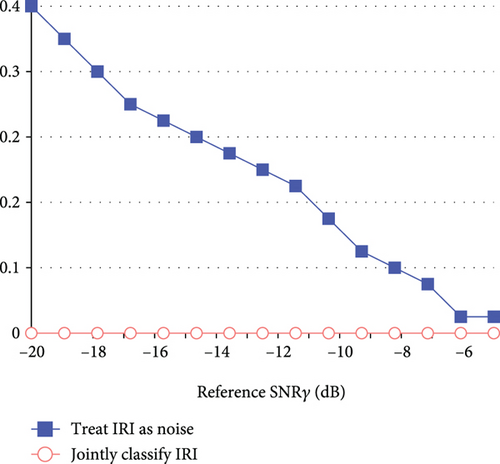
Since the analytical closed-form expressions of μlp and are difficult to obtain, numerical methods are generally used to calculate their approximate results.
3. The Ternary Interactive Education Model in Business English Writing
The ternary interactive determinism is an effective mechanism research paradigm to explain the behavioral results of individuals due to the action of internal and external factors. Its model is shown in Figure 2.
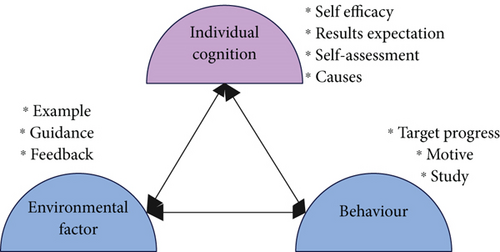
According to the person in charge of different tasks in the actual work process, the working situations of these three are different, so they are regarded as a frame of reference for horizontal alignment. From a vertical point of view, the work of the above three has certain commonalities, so we regard the tasks in charge of the three as the carrier, thus forming a three-dimensional structure. Through the study and practice of these 3 situations, we weave the rules of job growth and English writing tasks into a web. When students practice each step, they also use action thinking to understand various informations and make various decisions and plans. At the same time, they also completed the three major steps of inspection and evaluation. Students can master the specific workflow of different roles, as shown in Figure 3.
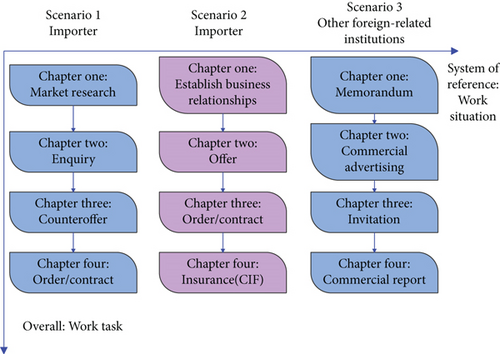
4. Simulation Verification
In order to calculate the correct recognition rate of the algorithm in the test set or , it is necessary to test all 9 modulation pairs, and then average the recognition rate. The calculation formula is as follows: Pc = Nc/Ntotal. Nc is the number of correct recognitions, and Ntotal is the total number of tests.
As shown in Figure 4, we simulated the performance curve of the correct recognition rate of the modulation method recognition algorithm based on the likelihood function with the reference signal-to-noise ratio γ. The abscissa is the value of γ, and the ordinate is the correct recognition rate Pc of the algorithm under a certain modulation mode candidate set. The curve of label Proposed is the recognition performance curve of the algorithm for joint recognition of interference proposed in this chapter, and the curve of label Traditional is the traditional algorithm recognition performance curve that regards interference as color noise. The solid line is the simulation result under the modulation mode candidate set , and the dashed line is the simulation result under the modulation mode candidate set . Compared with the modulation method recognition algorithm, the recognition performance of the algorithm based on ALRT is obviously higher than that of the algorithm in Chapter 4. At γ = −6dB, the correct recognition rate of the algorithm for joint recognition of interference is above 95%. Moreover, comparing the performance curves of the algorithm for joint recognition of interference and the algorithm that treats interference as colored noise, it can be clearly seen that the modulation method for joint recognition of interference greatly improves the recognition performance of the source signal modulation method. This conclusion holds no matter in the candidate set or , and with the increase of the signal-to-noise ratio, the difference between the two algorithms becomes larger and larger.
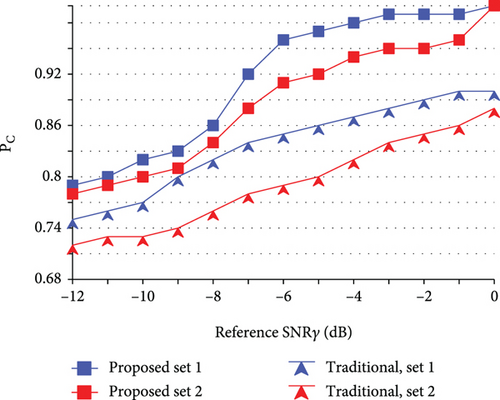
As shown in Figure 5, we simulate the performance of the modulation method recognition algorithm based on the relative distance from the source node to the relay node and between the relay nodes.
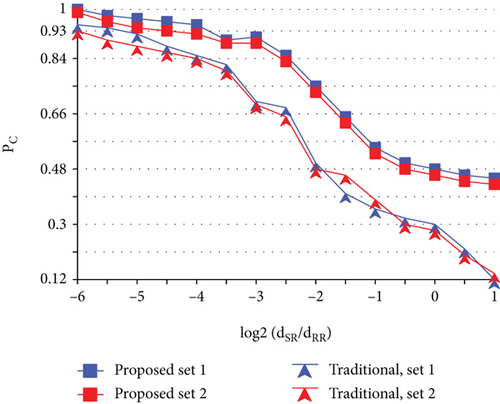
As shown in Figure 6, we study the relationship between the recognition performance of the algorithm and the number of signal symbols, and we only conduct simulations under the modulation mode candidate set . From the simulation results, with the increase of the number of signal symbols, the correct recognition probability of the algorithm will increase. This is because the number of signal symbols increases, the statistical characteristics are more obvious, and the similar variance corresponding to the probability distribution of the received signal will decrease. Therefore, the difference between the various modulation methods is more obvious, and the classification accuracy will increase. Of course, the correct recognition rate of the algorithm is also related to the signal-to-noise ratio. When the signal-to-noise ratio is high, in order to reduce the recognition time of the algorithm, a smaller number of symbols can be appropriately selected. For example, in the algorithm in this chapter, when γ = −4dB, it is enough to choose 150 signal symbols. When γ = −8dB, the number of signal symbols needs to be more than 300.

Of course, there are often mismatches in system parameters (frequency offset, phase offset, and timing offset) in the actual system, and sometimes these offsets will seriously affect the performance of the algorithm. Therefore, we simulated the performance of the source signal modulation method recognition algorithm for joint recognition of interference based on the likelihood function when the frequency offset occurred in the system. The simulation results are shown in Figure 7.
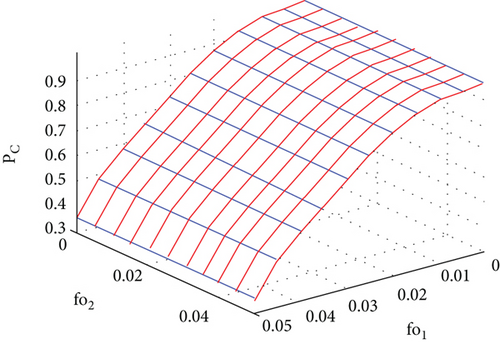
Through the above experiments, it is verified that the system algorithm proposed in this paper has a good operating effect. On this basis, the simulation system is used to test the ecological concept of ternary interactive education in business English writing, and the effect of the business English writing education system based on the ternary interactive concept is verified. The results shown in Table 1 below are obtained.
| Num | Educational effect | Num | Educational effect | Num | Educational effect |
|---|---|---|---|---|---|
| 1 | 83.54 | 21 | 86.45 | 41 | 87.89 |
| 2 | 84.59 | 22 | 81.46 | 42 | 86.79 |
| 3 | 87.83 | 23 | 85.66 | 43 | 87.26 |
| 4 | 85.19 | 24 | 86.23 | 44 | 81.16 |
| 5 | 87.67 | 25 | 80.66 | 45 | 82.60 |
| 6 | 82.59 | 26 | 81.22 | 46 | 84.00 |
| 7 | 83.28 | 27 | 87.16 | 47 | 81.68 |
| 8 | 83.63 | 28 | 87.71 | 48 | 85.96 |
| 9 | 79.31 | 29 | 87.09 | 49 | 81.48 |
| 10 | 82.47 | 30 | 83.34 | 50 | 86.97 |
| 11 | 87.29 | 31 | 81.29 | 51 | 81.48 |
| 12 | 82.17 | 32 | 83.61 | 52 | 81.76 |
| 13 | 82.91 | 33 | 79.77 | 53 | 81.54 |
| 14 | 80.21 | 34 | 87.12 | 54 | 81.36 |
| 15 | 84.74 | 35 | 81.09 | 55 | 84.85 |
| 16 | 79.81 | 36 | 84.98 | 56 | 82.93 |
| 17 | 87.85 | 37 | 85.10 | 57 | 80.35 |
| 18 | 84.80 | 38 | 83.91 | 58 | 85.70 |
| 19 | 84.41 | 39 | 80.00 | 59 | 85.64 |
| 20 | 80.59 | 40 | 82.82 | 60 | 81.72 |
Through the above research, it can be seen that the business English education system based on the ternary interaction concept proposed in this paper can effectively improve the effect of business English writing education.
5. Conclusion
The training goal of the business English writing course is to enable students to use English proficiently to deal with business matters in the workplace. The traditional teaching method, on the one hand, makes business English writing class become monotonous, and the classroom is difficult to be vivid, and the students’ willingness to learn in this area will be reduced. On the other hand, it makes the knowledge explanation of business English writing only stay at the level of learning and reception, lack of practicality, less connection between theory and practice, and students’ ability to make achievements in practice will be insufficient. This paper combines intelligent algorithms to study the ecological concept of ternary interactive education in business English writing, so as to improve the effect of business English teaching. Through the experimental research, it can be seen that the business English education system based on the ternary interaction concept proposed in this paper can effectively improve the effect of business English writing education.
Conflicts of Interest
The author declares no competing interests.
Acknowledgments
This work was supported by Henan Polytechnic Institute.
Open Research
Data Availability
The labeled dataset used to support the findings of this study are available from the corresponding author upon request.




